Description (Page 1)
 The ancient diamond shaped country of India, the largest region of the Indian Subcontinent, extends from the Himalayan Mountains in the north and south into the tropical reaches of the Indian Ocean. It's the second most populous country in the world, and certainly one of the most intriguing.
The ancient diamond shaped country of India, the largest region of the Indian Subcontinent, extends from the Himalayan Mountains in the north and south into the tropical reaches of the Indian Ocean. It's the second most populous country in the world, and certainly one of the most intriguing.
This diverse and fertile country, which once included the lands of today's Bangladesh and Pakistan, was plundered over eons of time.
Its history begins some 500,000 years ago as early hominids graced the land, and from 3300 to 1300 BC the Indus River Valley Civilization flourished.
The sophisticated and technologically advanced Mature Harappan period followed, lasting around 700 years before collapsing and giving rise to the Iron Age Vedic Civilization during the second millennium BC.
India and much of Asia were conquered by Cyrus the Great of Persia in 530 BC and Alexander the Great in 326 BC. Together the Persian and Greek invasions left a lasting impression on Indian civilization, with the Persian's influencing future forms of government.
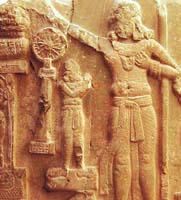 The Mauryan dynasty rose to power in 322 BC, and flourished under the
leadership of Ashoka the Great - becoming one of the most powerful
political and military empires in ancient India.
The Mauryan dynasty rose to power in 322 BC, and flourished under the
leadership of Ashoka the Great - becoming one of the most powerful
political and military empires in ancient India.
A succession of weaker kings followed, which contributed to the rapid downfall of the Mauryan dynasty, and by 185 BC the Mauryan dynasty had completely dissolved.
India's "Classical Age" began around the 7th century AD with the Gupta Empire. It was during this time frame that development of India's main spiritual and philosophical systems in Hinduism, Buddhism, and Jainism continued.
 The Gurjara Pratiharas of Malwa, Eastern Ganga dynasty of Orissa,
Rashtrakutas of the Deccan, and the Palas of Bengal all fought for
control of northern India between the 7th and 9th centuries. But it was
the Sena dynasty who prevailed, and assumed control of the Pala Empire,
dividing the Gurjara Pratiharas into various states.
The Gurjara Pratiharas of Malwa, Eastern Ganga dynasty of Orissa,
Rashtrakutas of the Deccan, and the Palas of Bengal all fought for
control of northern India between the 7th and 9th centuries. But it was
the Sena dynasty who prevailed, and assumed control of the Pala Empire,
dividing the Gurjara Pratiharas into various states.
These states were the first of the Rajput, who became an array of kingdoms managing to exist in some form or another for nearly a millennium.
Description (Page 2)
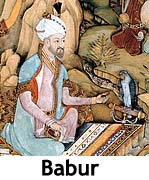 Babur, a descendant of Timur and Genghis Khan, swept through the region
in 1526, establishing the Mughal Empire - one of the richest single
dynasties ever to have existed.
Babur, a descendant of Timur and Genghis Khan, swept through the region
in 1526, establishing the Mughal Empire - one of the richest single
dynasties ever to have existed.
Often employing brutal tactics to overpower their empire, the Mughals ruled a vast amount of the Indian subcontinent, and prospered under Akbar the Great.
The Mughals slowly began to disintegrate throughout the 1700s, with the Indian Rebellion of 1857 that caused their eventual collapse - marking an immense social change over India.
Lines began to blur between commercial and political dominance in the early 18th century, and a number of European trading companies set up coastal outposts for their trading companies, including the East India Company.
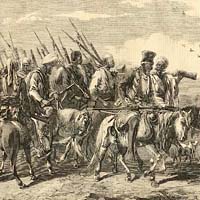 In the aftermath of the rebellion a power shift within the British Crown came to light, and subsequently India was colonized and ruled by Britain throughout much of the 19th and 20th centuries.
In the aftermath of the rebellion a power shift within the British Crown came to light, and subsequently India was colonized and ruled by Britain throughout much of the 19th and 20th centuries.
During the British Raj (the age of ruling over India) the large province of Bengal was split into two halves, with the western half primarily Hindu, and the eastern largely Muslim.
Persistent famines were common during this period, with the worst ever recorded being the Great Famine of 1876-78 in which nearly 10 million perished, followed by one of almost equal proportions in 1899. Despite the widescale loss, the population continued to boom, reaching 389 million people by 1941 - up from 125 million in 1750.
Although the number of British forces in India were small, they managed to control two-thirds of the subcontinent directly.
 A push for independence grew steadily in the early 1900s, along with
tensions between the Hindus and Muslims. As a minority, the Muslims were
cautious, due to the prospect of an almost exclusive Hindu-based
government, and tensions between the two flared.
A push for independence grew steadily in the early 1900s, along with
tensions between the Hindus and Muslims. As a minority, the Muslims were
cautious, due to the prospect of an almost exclusive Hindu-based
government, and tensions between the two flared.
Mohandas Gandhi took the leadership role of the Indian National Congress in 1920, and called for unity between the Hindus and Muslims. Gandhi's approach was that of non-violence, and he was well-known for his restraint and moderation, as well as inspiring movements for civil rights and freedom across the entire world.
A civil disobedience movement was launched in the late summer of 1942, as a response to Gandhi's call for Indian independence. Following the Second World War, weakened British forces retreated from India, and, in 1947, India declared independence and formed its own country.
Riots broke out between Sikhs, Hindus and Muslims, following a controversial division of Punjab and Bengal territories, and spread to several regions within India.
 In addition to the riots, one of the largest mass migrations ever
recorded in modern history occurred, with over 12 million Hindus, Sikhs
and Muslims migrating through the newly created nations of India and Pakistan.
In addition to the riots, one of the largest mass migrations ever
recorded in modern history occurred, with over 12 million Hindus, Sikhs
and Muslims migrating through the newly created nations of India and Pakistan.
Throughout the next several decades, India's economy saw a mixture of successes and failures, but continued to remain a democracy with civil liberties. However, the country continues to play host to both rural and urban poverty, and unresolved territorial disputes with China and Pakistan.
During the 1990s economic liberalization began, establishing an extensive urban middle class, and revolutionizing India into one of the fastest-growing economies in the world.
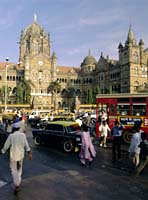 Home to some of the most significant natural and man-made wonders on
the planet, and thus, a powerful exotic tourism magnet, the modern
open-door policies of India have put the tourist industry here on the
fast-track, as luxury hotels and beach resorts are constantly under
construction.
Home to some of the most significant natural and man-made wonders on
the planet, and thus, a powerful exotic tourism magnet, the modern
open-door policies of India have put the tourist industry here on the
fast-track, as luxury hotels and beach resorts are constantly under
construction.
With numerous major languages and hundreds of dialects, dozens and dozens of large cities and over 700,000 villages, India offers both the classic, traditional rituals of its many cultures, and the fast-moving world of the 21st century.
print this map print this map


The Himalayas form the highest mountain range in the world, and slope southward into a large fertile plain that covers much of India.
Three mountain ranges extend from the Indus River in the northwest, to the Brahmaputra River in the east, including the Himadri, Himachal and Shivaliks - all with deep canyons gorged by the fast-flowing water.
India's highest point is Kanchenjunga which rises 28,208 ft. (8,598 m).
The land rises slightly into two plateaus, bordered in the central and south by lower mountains (Ghats), that gently slope into narrow coastal plains.
Numerous rivers drain the land, and without question, the Ganges is the heartbeat of India and one of the most significant rivers on the planet.
 The ancient diamond shaped country of India, the largest region of the Indian Subcontinent, extends from the Himalayan Mountains in the north and south into the tropical reaches of the Indian Ocean. It's the second most populous country in the world, and certainly one of the most intriguing.
The ancient diamond shaped country of India, the largest region of the Indian Subcontinent, extends from the Himalayan Mountains in the north and south into the tropical reaches of the Indian Ocean. It's the second most populous country in the world, and certainly one of the most intriguing. This diverse and fertile country, which once included the lands of today's Bangladesh and Pakistan, was plundered over eons of time.
Its history begins some 500,000 years ago as early hominids graced the land, and from 3300 to 1300 BC the Indus River Valley Civilization flourished.
The sophisticated and technologically advanced Mature Harappan period followed, lasting around 700 years before collapsing and giving rise to the Iron Age Vedic Civilization during the second millennium BC.
India and much of Asia were conquered by Cyrus the Great of Persia in 530 BC and Alexander the Great in 326 BC. Together the Persian and Greek invasions left a lasting impression on Indian civilization, with the Persian's influencing future forms of government.
 The Mauryan dynasty rose to power in 322 BC, and flourished under the
leadership of Ashoka the Great - becoming one of the most powerful
political and military empires in ancient India.
The Mauryan dynasty rose to power in 322 BC, and flourished under the
leadership of Ashoka the Great - becoming one of the most powerful
political and military empires in ancient India. A succession of weaker kings followed, which contributed to the rapid downfall of the Mauryan dynasty, and by 185 BC the Mauryan dynasty had completely dissolved.
India's "Classical Age" began around the 7th century AD with the Gupta Empire. It was during this time frame that development of India's main spiritual and philosophical systems in Hinduism, Buddhism, and Jainism continued.
 The Gurjara Pratiharas of Malwa, Eastern Ganga dynasty of Orissa,
Rashtrakutas of the Deccan, and the Palas of Bengal all fought for
control of northern India between the 7th and 9th centuries. But it was
the Sena dynasty who prevailed, and assumed control of the Pala Empire,
dividing the Gurjara Pratiharas into various states.
The Gurjara Pratiharas of Malwa, Eastern Ganga dynasty of Orissa,
Rashtrakutas of the Deccan, and the Palas of Bengal all fought for
control of northern India between the 7th and 9th centuries. But it was
the Sena dynasty who prevailed, and assumed control of the Pala Empire,
dividing the Gurjara Pratiharas into various states. These states were the first of the Rajput, who became an array of kingdoms managing to exist in some form or another for nearly a millennium.
Description (Page 2)
 Babur, a descendant of Timur and Genghis Khan, swept through the region
in 1526, establishing the Mughal Empire - one of the richest single
dynasties ever to have existed.
Babur, a descendant of Timur and Genghis Khan, swept through the region
in 1526, establishing the Mughal Empire - one of the richest single
dynasties ever to have existed.Often employing brutal tactics to overpower their empire, the Mughals ruled a vast amount of the Indian subcontinent, and prospered under Akbar the Great.
The Mughals slowly began to disintegrate throughout the 1700s, with the Indian Rebellion of 1857 that caused their eventual collapse - marking an immense social change over India.
Lines began to blur between commercial and political dominance in the early 18th century, and a number of European trading companies set up coastal outposts for their trading companies, including the East India Company.
 In the aftermath of the rebellion a power shift within the British Crown came to light, and subsequently India was colonized and ruled by Britain throughout much of the 19th and 20th centuries.
In the aftermath of the rebellion a power shift within the British Crown came to light, and subsequently India was colonized and ruled by Britain throughout much of the 19th and 20th centuries. During the British Raj (the age of ruling over India) the large province of Bengal was split into two halves, with the western half primarily Hindu, and the eastern largely Muslim.
Persistent famines were common during this period, with the worst ever recorded being the Great Famine of 1876-78 in which nearly 10 million perished, followed by one of almost equal proportions in 1899. Despite the widescale loss, the population continued to boom, reaching 389 million people by 1941 - up from 125 million in 1750.
Although the number of British forces in India were small, they managed to control two-thirds of the subcontinent directly.
 A push for independence grew steadily in the early 1900s, along with
tensions between the Hindus and Muslims. As a minority, the Muslims were
cautious, due to the prospect of an almost exclusive Hindu-based
government, and tensions between the two flared.
A push for independence grew steadily in the early 1900s, along with
tensions between the Hindus and Muslims. As a minority, the Muslims were
cautious, due to the prospect of an almost exclusive Hindu-based
government, and tensions between the two flared. Mohandas Gandhi took the leadership role of the Indian National Congress in 1920, and called for unity between the Hindus and Muslims. Gandhi's approach was that of non-violence, and he was well-known for his restraint and moderation, as well as inspiring movements for civil rights and freedom across the entire world.
A civil disobedience movement was launched in the late summer of 1942, as a response to Gandhi's call for Indian independence. Following the Second World War, weakened British forces retreated from India, and, in 1947, India declared independence and formed its own country.
Riots broke out between Sikhs, Hindus and Muslims, following a controversial division of Punjab and Bengal territories, and spread to several regions within India.
 In addition to the riots, one of the largest mass migrations ever
recorded in modern history occurred, with over 12 million Hindus, Sikhs
and Muslims migrating through the newly created nations of India and Pakistan.
In addition to the riots, one of the largest mass migrations ever
recorded in modern history occurred, with over 12 million Hindus, Sikhs
and Muslims migrating through the newly created nations of India and Pakistan. Throughout the next several decades, India's economy saw a mixture of successes and failures, but continued to remain a democracy with civil liberties. However, the country continues to play host to both rural and urban poverty, and unresolved territorial disputes with China and Pakistan.
During the 1990s economic liberalization began, establishing an extensive urban middle class, and revolutionizing India into one of the fastest-growing economies in the world.
 Home to some of the most significant natural and man-made wonders on
the planet, and thus, a powerful exotic tourism magnet, the modern
open-door policies of India have put the tourist industry here on the
fast-track, as luxury hotels and beach resorts are constantly under
construction.
Home to some of the most significant natural and man-made wonders on
the planet, and thus, a powerful exotic tourism magnet, the modern
open-door policies of India have put the tourist industry here on the
fast-track, as luxury hotels and beach resorts are constantly under
construction. With numerous major languages and hundreds of dialects, dozens and dozens of large cities and over 700,000 villages, India offers both the classic, traditional rituals of its many cultures, and the fast-moving world of the 21st century.
print this map print this map
- Name: India
(long form) Republic of India - Capital City: New Delhi (249,998 mun. corp. pop.)
(21,753,386 metro) - India Population: 1,220,800,359 (2013 est.)
- World Populations (all countries)
- Currency: Indian Rupee (INR)
(conversion rates)
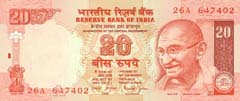
20 Indian Rupees - Ethnicity: Indo-Aryan 72%, Dravidian 25%, Mongoloid and other 3%
- GDP total: $4.784 trillion (2012 est.)
- GDP per capita: $3,900 (2012 est.)
- Land Sizes

- Language: Hindi 41%, Bengali 8.1%, Telugu 7.2%,
Marathi 7%, Tamil 5.9%, Urdu 5%, Gujarati 4.5%, Kannada 3.7%, Malayalam
3.2%, Oriya 3.2%, Punjabi 2.8%, Assamese 1.3%, Maithili 1.2%, other 5.9%
Note: English is the subsidiary official language, but is the most important language for national, political, and commercial communication; Hindi is the most widely spoken language and primary tongue of 41% of the people; there are 14 other official languages: Bengali, Telugu, Marathi, Tamil, Urdu, Gujarati, Malayalam, Kannada, Oriya, Punjabi, Assamese, Kashmiri, Sindhi, and Sanskrit; Hindustani is a popular variant of Hindi/Urdu spoken widely throughout northern India but is not an official language - Largest Cities: (by population) Mumbai (Bombay), Delhi, Calcutta, Bangalore, Chennai (Madras)
- Name: From the Old Persian word Hindu, the local name for the Indus River
- National Day: January 26
- Religion: Hindu 80.5%, Muslim 13.4%, Christian 2.3%, Sikh 1.9%, other 1.8%, unspecified 0.1%

The Himalayas form the highest mountain range in the world, and slope southward into a large fertile plain that covers much of India.
Three mountain ranges extend from the Indus River in the northwest, to the Brahmaputra River in the east, including the Himadri, Himachal and Shivaliks - all with deep canyons gorged by the fast-flowing water.
India's highest point is Kanchenjunga which rises 28,208 ft. (8,598 m).
The land rises slightly into two plateaus, bordered in the central and south by lower mountains (Ghats), that gently slope into narrow coastal plains.
Numerous rivers drain the land, and without question, the Ganges is the heartbeat of India and one of the most significant rivers on the planet.
No comments:
Post a Comment